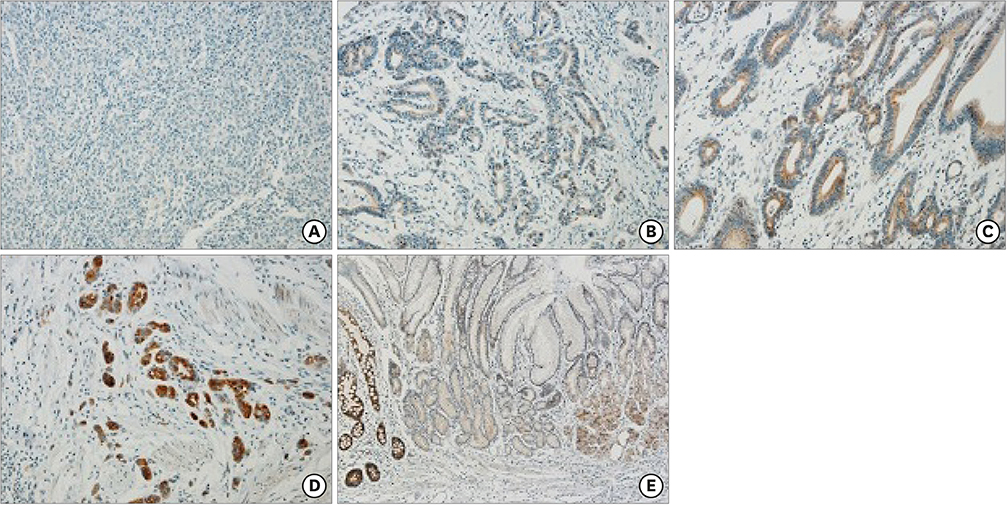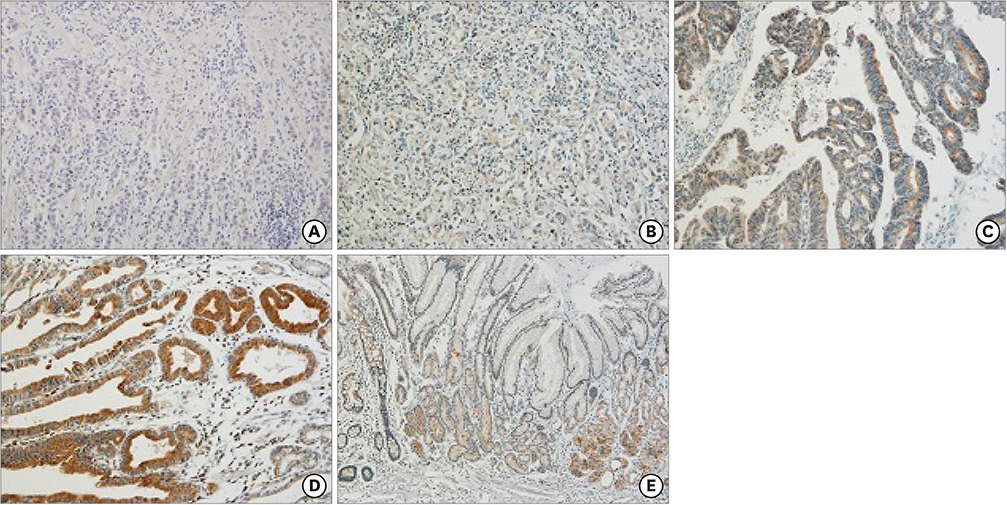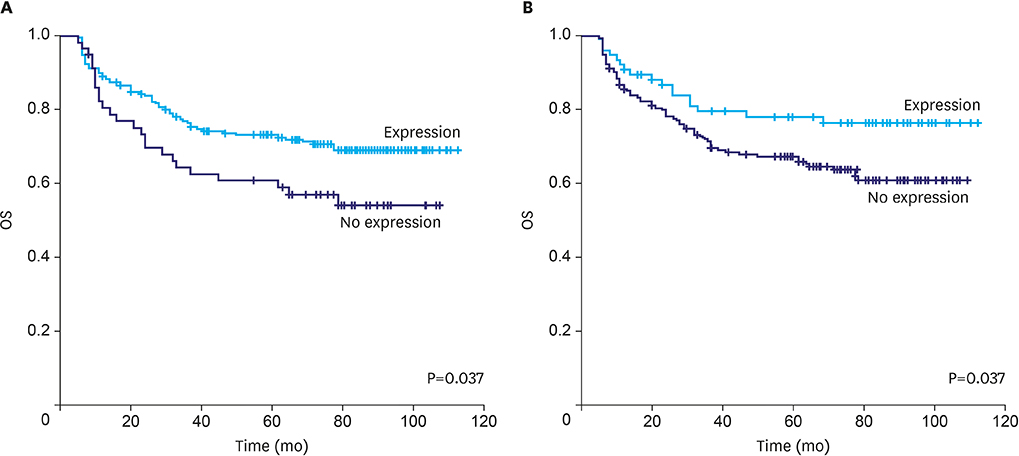J Gastric Cancer.
2017 Dec;17(4):363-373. 10.5230/jgc.2017.17.e41.
Clinicopathological Significance of Large Tumor Suppressor (LATS) Expression in Gastric Cancer
- Affiliations
-
- 1Department of Surgery, Soonchunhyang University Cheonan Hospital, Cheonan, Korea. msslee@schmc.ac.kr
- 2Department of Pathology, Soonchunhyang University Cheonan Hospital, Cheonan, Korea.
- KMID: 2398802
- DOI: http://doi.org/10.5230/jgc.2017.17.e41
Abstract
- PURPOSE
The aims of this study were to evaluate the expression of the large tumor suppressor (LATS) genes LATS1 and LATS2 by immunohistochemical staining of gastric cancer, and to evaluate the clinicopathological significance of LATS expression and its correlation with overall survival (OS).
MATERIALS AND METHODS
LATS1 and LATS2 expression in a tissue microarray was detected by immunohistochemistry, using 264 gastric cancer specimens surgically resected between July 2006 and December 2009.
RESULTS
Low expression of LATS1 was significantly associated with more advanced American Joint Committee on Cancer (AJCC) stage (P=0.001) and T stage (P=0.032), lymph node (LN) metastasis (P=0.040), perineural invasion (P=0.042), poor histologic grade (P=0.007), and diffuse-type histology by the Lauren classification (P=0.033). Low expression of LATS2 was significantly correlated with older age (≥65, P=0.027), more advanced AJCC stage (P=0.001) and T stage (P=0.001), LN metastasis (P=0.004), perineural invasion (P=0.004), poor histologic grade (P<0.001), and diffuse-type histology by the Lauren classification (P<0.001). Kaplan-Meier survival analysis revealed significantly poor OS rates in the groups with low LATS1 (P=0.037) and LATS2 (P=0.037) expression.
CONCLUSIONS
Expression of LATS1 or LATS2 is a significant marker for a good prognosis in patients with gastric cancer.
MeSH Terms
Figure
Reference
-
1. Bertuccio P, Chatenoud L, Levi F, Praud D, Ferlay J, Negri E, et al. Recent patterns in gastric cancer: a global overview. Int J Cancer. 2009; 125:666–673.2. Bosetti C, Bertuccio P, Malvezzi M, Levi F, Chatenoud L, Negri E, et al. Cancer mortality in Europe, 2005–2009, and an overview of trends since 1980. Ann Oncol. 2013; 24:2657–2671.3. Oh CM, Won YJ, Jung KW, Kong HJ, Cho H, Lee JK, et al. Cancer statistics in Korea: incidence, mortality, survival, and prevalence in 2013. Cancer Res Treat. 2016; 48:436–450.4. Justice RW, Zilian O, Woods DF, Noll M, Bryant PJ. The Drosophila tumor suppressor gene warts encodes a homolog of human myotonic dystrophy kinase and is required for the control of cell shape and proliferation. Genes Dev. 1995; 9:534–546.5. Xu T, Wang W, Zhang S, Stewart RA, Yu W. Identifying tumor suppressors in genetic mosaics: the Drosophila lats gene encodes a putative protein kinase. Development. 1995; 121:1053–1063.6. Visser S, Yang X. LATS tumor suppressor: a new governor of cellular homeostasis. Cell Cycle. 2010; 9:3892–3903.7. Oh HJ, Lee KK, Song SJ, Jin MS, Song MS, Lee JH, et al. Role of the tumor suppressor RASSF1A in Mst1-mediated apoptosis. Cancer Res. 2006; 66:2562–2569.8. Zhao B, Li L, Lei Q, Guan KL. The Hippo-YAP pathway in organ size control and tumorigenesis: an updated version. Genes Dev. 2010; 24:862–874.9. Zhao B, Wei X, Li W, Udan RS, Yang Q, Kim J, et al. Inactivation of YAP oncoprotein by the Hippo pathway is involved in cell contact inhibition and tissue growth control. Genes Dev. 2007; 21:2747–2761.10. Zhou D, Conrad C, Xia F, Park JS, Payer B, Yin Y, et al. Mst1 and Mst2 maintain hepatocyte quiescence and suppress hepatocellular carcinoma development through inactivation of the Yap1 oncogene. Cancer Cell. 2009; 16:425–438.11. Xia H, Qi H, Li Y, Pei J, Barton J, Blackstad M, et al. LATS1 tumor suppressor regulates G2/M transition and apoptosis. Oncogene. 2002; 21:1233–1241.12. Zeng Q, Hong W. The emerging role of the hippo pathway in cell contact inhibition, organ size control, and cancer development in mammals. Cancer Cell. 2008; 13:188–192.13. Zhou Y, Tao F, Cheng Y, Xu F, Yao F, Feng D, et al. Up-regulation of ITCH is associated with down-regulation of LATS1 during tumorigenesis and progression of cervical squamous cell carcinoma. Clin Invest Med. 2014; 37:E384–E394.14. Morinaga N, Shitara Y, Yanagita Y, Koida T, Kimura M, Asao T, et al. Molecular analysis of the h-warts/LATS1 gene in human breast cancer. Int J Oncol. 2000; 17:1125–1129.15. Li H, Wolfe A, Septer S, Edwards G, Zhong X, Abdulkarim AB, et al. Deregulation of Hippo kinase signalling in human hepatic malignancies. Liver Int. 2012; 32:38–47.16. Xu ZP, Zhu JS, Zhang Q, Wang XY. A breakdown of the Hippo pathway in gastric cancer. Hepatogastroenterology. 2011; 58:1611–1617.17. Kim KJ, Jung HY, Oh MH, Cho H, Lee JH, Lee HJ, et al. Loss of ARID1A expression in gastric cancer: correlation with mismatch repair deficiency and clinicopathologic features. J Gastric Cancer. 2015; 15:201–208.18. Tao W, Zhang S, Turenchalk GS, Stewart RA, St John MA, Chen W, et al. Human homologue of the Drosophila melanogaster lats tumour suppressor modulates CDC2 activity. Nat Genet. 1999; 21:177–181.19. Yabuta N, Fujii T, Copeland NG, Gilbert DJ, Jenkins NA, Nishiguchi H, et al. Structure, expression, and chromosome mapping of LATS2, a mammalian homologue of the Drosophila tumor suppressor gene lats/warts. Genomics. 2000; 63:263–270.20. Furth N, Ben-Moshe NB, Pozniak Y, Porat Z, Geiger T, Domany E, et al. Down-regulation of LATS kinases alters p53 to promote cell migration. Genes Dev. 2015; 29:2325–2330.21. Powzaniuk M, McElwee-Witmer S, Vogel RL, Hayami T, Rutledge SJ, Chen F, et al. The LATS2/KPM tumor suppressor is a negative regulator of the androgen receptor. Mol Endocrinol. 2004; 18:2011–2023.22. Yu T, Bachman J, Lai ZC. Evidence for a tumor suppressor role for the large tumor suppressor genes LATS1 and LATS2 in human cancer. Genetics. 2013; 195:1193–1196.23. Lin XY, Zhang XP, Wu JH, Qiu XS, Wang EH. Expression of LATS1 contributes to good prognosis and can negatively regulate YAP oncoprotein in non-small-cell lung cancer. Tumour Biol. 2014; 35:6435–6443.
- Full Text Links
- Actions
-
Cited
- CITED
-
- Close
- Share
- Similar articles
-
- Clinicopathological Significance of p53 and HSP27 in Gastric-cancer Patients
- Expression of Oncogenes in Gastric Cancer: As a Correlation between Oncogene Expression and Prognosis
- Clinicopathological Significance of Maspin Expression in Breast Cancer
- Expression of Maspin is associated with the Intestinal Type of Gastric Adenocarcinoma
- The Immunohistochemical Study on the Expression of p53 Tumor Suppressor Gene in the Gastric Adenocarcinoma




